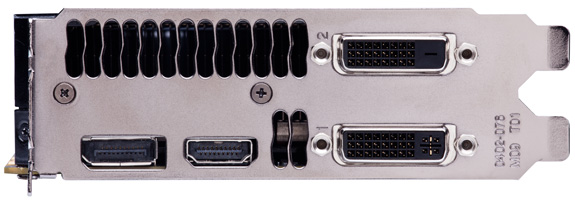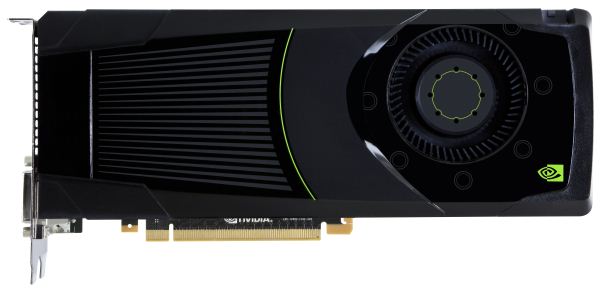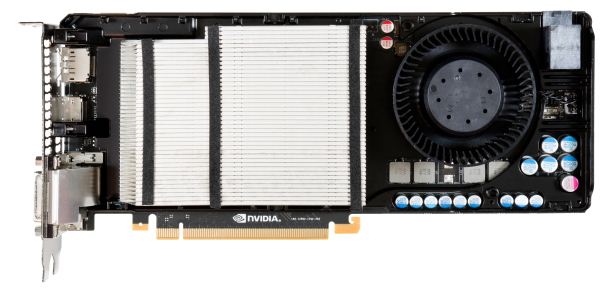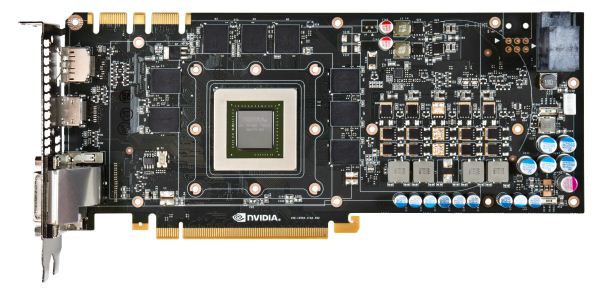NVIDIA GeForce GTX 680 Review: Retaking The Performance Crown
by Ryan Smith on March 22, 2012 9:00 AM ESTMeet the GeForce GTX 680
All things considered the design of the GeForce GTX 680 is not a radical departure from the GTX 580, but at the same time it also has some distinct differences owing to the fact that its TDP is some 50W lower than GTX 580.
Like the past GTX x80 cards, the basic design of the GTX 680 is that of a blower. A radial fan at the rear of the card sucks in air and pushes it towards the front of the card. Notably, due to a combination of card length and the fan position, the “wedge” around the fan has been done away with. NVIDIA tells us that this shouldn’t significantly impact the cooling of the card, particularly since it has a lower TDP in the first place, but when used in SLI it will remove some of the breathing room than the GTX 580 enjoyed.
Looking at the fan itself, compared to the GTX 580 the fan has been moved from the center of the card to the top of the card. This is due to NVIDIA’s port configuration, which uses a stacked DVI connector that consumes what would have normally been part of the exhaust vent on the GTX 580. We’ll get into the port configuration more in a minute, but for the moment the significance is that because the GTX 680 only has half a vent NVIDIA has moved the fan to match the vent, which is why the fan has been moved up.
On that note, the repositioning of the fan also had its own ramifications. Because the fan is now so close to the top and at the same time so close to the rear, NVIDIA went with a unique method of arranging the PCIe power sockets. Rather than having them side-by-side as we’ve seen on countless NVIDIA cards in the past, the sockets are stacked on each other in a staggered configuration. With the fan otherwise occupying the space that one of the sockets would take up, this configuration allowed NVIDIA to have two sockets without lengthening the card just to fit another socket. Overall this staggered design is not too difficult to work with, though with one socket facing the opposite way it might require some cable repositioning if you have a well maintained cable run.
Moving on, when we remove the shroud on the GTX 680 we see the fan, baseplate, and heatsink in full detail. NVIDIA is using an aluminum fin stacked heatsink, very similar to what we saw on the GTX 580. Underneath the heatsink NVIDIA is using a set of three heatpipes to transfer heat between the GPU and the heatsink. This is as opposed to the vapor chamber on the GTX 580, and while this setup doesn’t allow empirical testing, given the high efficiency of vapor chambers it’s likely that this isn’t quite as efficient, though to what degree we couldn’t say.
Finally, after removing the fan, baseplate, and heatsink, we can see the PCB in full detail. Unlike GF110 and GF114, GK104 is not capped with an IHS, allowing for the heatsink to directly come in contact with the GPU die. Meanwhile arranged around the GPU we can see the 8 2Gb GDDR5 RAM modules that give the GTX 680 its 2GB of RAM. These are Hynix R0C modules, which means they’re rated for 6GHz, the stock memory speed for the GTX 680. Overall the card measures 10” long with no overhang from the shroud, making it 0.5” shorter than the GTX 580.
Looking at the top of the card, as always we see the SLI connectors. Following in the footsteps of the GTX 580, the GTX 680 features 2 SLI connectors, allowing for up to 3-way SLI.
Meanwhile at the front of the card we see the I/O bracket. As we alluded to previously, the GTX 680 uses a stacked DVI design here; NVIDIA has done everything they can to keep the DVI ports at the very bottom of the card to avoid impeding airflow, but the upper DVI port still occupies roughly 40% of what would otherwise be the vent. Altogether the GTX 680 features 2 DL-DVI ports, a full size HDMI port, and a full size DisplayPort.

While NVIDIA has used DVI and HDMI ports for quite some time, this is the first time NVIDIA has included DIsplayPort on a reference design. Unfortunately we find that this ruffles our feathers a bit, although this isn’t strictly NVIDIA’s fault. As we’ve covered in the past, DisplayPort comes in both a full size and miniDP configuration – AMD in particular has used miniDP since the Radeon HD 6800 series in 2010. And while we’re happy to see DisplayPort finally make it into an NVIDIA reference design, the fact that it’s a full size DisplayPort is less than encouraging because at this point in time DisplayPort has largely been replaced by miniDP.
Ultimately the fault for this lies more with the VESA than NVIDIA, but it’s indicative of a larger problem in the DisplayPort community in that both full size DP and miniDP are equally valid and equally capable ports. While full size DisplayPort has the distinction of coming first, thanks in large part to Apple it has largely been displaced by miniDP as the most common variant on source devices. The problem with this is that both miniDP and DisplayPort are now in wide use; wide, redundant use.
At this point desktop computers and video cards coming with full size DisplayPorts is silly at best, and frustrating at worst. The laptop guys aren’t going to give up miniDP due to the space savings, and there’s no significantly good reason to use DisplayPort on desktops when miniDP offers the same functionality. We would rather see the PC industry standardize on miniDP across all source devices, and thereby eliminate any ambiguity with regards to what cables or adaptors are necessary. DisplayPort adoption has been slow enough – having 2 variants of the port on source devices only makes it more confusing for everyone.
Finally, while we’re on the subject of display connectivity we quickly took a look at how the idle clockspeeds of GTX 680 are impacted by the use of multiple displays. With 2 displays GTX 680 can utilize its full idle clocks, but only if both displays are connected via a TMDS type connection (DVI/HDMI) and run with identical timings. But if different timings are used or if one display is connected via DisplayPort, then the GTX 680 will shift to its low power 3D clocks. However if we expand that to 3 monitors and enable NVIDIA Surround, then the GTX 680 can operate at full idle regardless of whether DisplayPort is used or not.













404 Comments
View All Comments
maximumGPU - Saturday, March 24, 2012 - link
"The benchmarks are tight in front of your faces!"and judging by your conclusion it seems you didn't even read them..
Skiddywinks - Saturday, March 24, 2012 - link
"The benchmarks are tight in front of your faces! "No s***, Sherlock.
"The 680 is tied with the 7950, which surpasses it by a little, and the 7970 is the leader. "
Clearly the benchmarks in front of my face are different to the ones in front of your face.
BoFox - Monday, March 26, 2012 - link
I know, that's why I'm telling him that Anandtech Forum is a perfect place for him!BoFox - Monday, March 26, 2012 - link
Then you'll love Anandtech Forums!! It's the perfect place for you! They'll love you over there!CeriseCogburn - Tuesday, March 27, 2012 - link
It's absolutely amazing isn't it.SR81 - Saturday, March 24, 2012 - link
HardOCP has surround benches on both the 680 and 7970, surprisingly the lower bandwidth/VRAM card wins even with 4XMSAA and FXAA enabled at 5760x1200 (ex.Skyrim: 680 = 58.6, 7970 = 45.4)When Anand updates this review with surround benches it will leave no doubt which card is the absolute king. I think the articles title is rightfully deserved once testing is done :)
CeriseCogburn - Saturday, March 24, 2012 - link
Yep, saw it like 2 days ago, the ram arguments have been foolish once you crank eye candy high enough (on weak ram cards) both comps frame rates are too low to matter.dtolios - Saturday, March 24, 2012 - link
I know the AMD vs. Nvidia war is a hot topic in Anandtech - just like any other tech forum/review site etc - but one of the really hard applications for modern GPUs is production rendering acceleration.There are multiple instances were you can see reviewers trying to compare different GPUs, different architectures, SLI combinations (or just multiple GPU) combinations etc while using GPU accelerated renderers, a professional application that is relying more and more on "game" oriented boards instead of Quadro / FireGL versions (unless vram limitations get in the way).
Testing on applications like Octane Rendered, Vray 2 GPU, iRay etc, would be a nice addition to your tests - not only because those are hard to find and easily more intensive than "just gaming", but also because few sites have access to such an extensive line of hardware to pull a realistic comparison, including multiple GPUs, different generations, scalability with multiple cards etc. The only "comparison tables" you can easily find, are from people sharing their personal observation on their blog or forum - under not that repeatable conditions etc...
For some apps, Open CL could be nice to keep on the AMD vs. nVidia "hype" going on, but sadly for some of us, most of these renderers are either exclusively CUDA based, or run better on it, so it would be nice to actually do core comparisons even within the nVidia line: you see, in rendering applications, getting better scalability with multiple cards, or removing 30min out of your 2hour rendering workflow is way more important than gaining 5% FPS advantage over the other card.
You do include 3DS or similar productivity comparisons in your CPU reviews, so it only make sense to include it for your GPUs too.
poordirtfarmer2 - Monday, March 26, 2012 - link
I agree wholeheartedly! I’d love to pick the best “gaming” card for also doing pro work. Although just an amateur, I actually find myself spending more time editing and rendering videos than I do playing games.AnnonymousCoward - Saturday, March 24, 2012 - link
When 2560x1600 4xAA results in way under 60fps, IMHO it's not a very useful benchmark. Any user would go to 2xAA or no AA, to get 60fps. So who really cares how these cards compare at a setting that's never used.